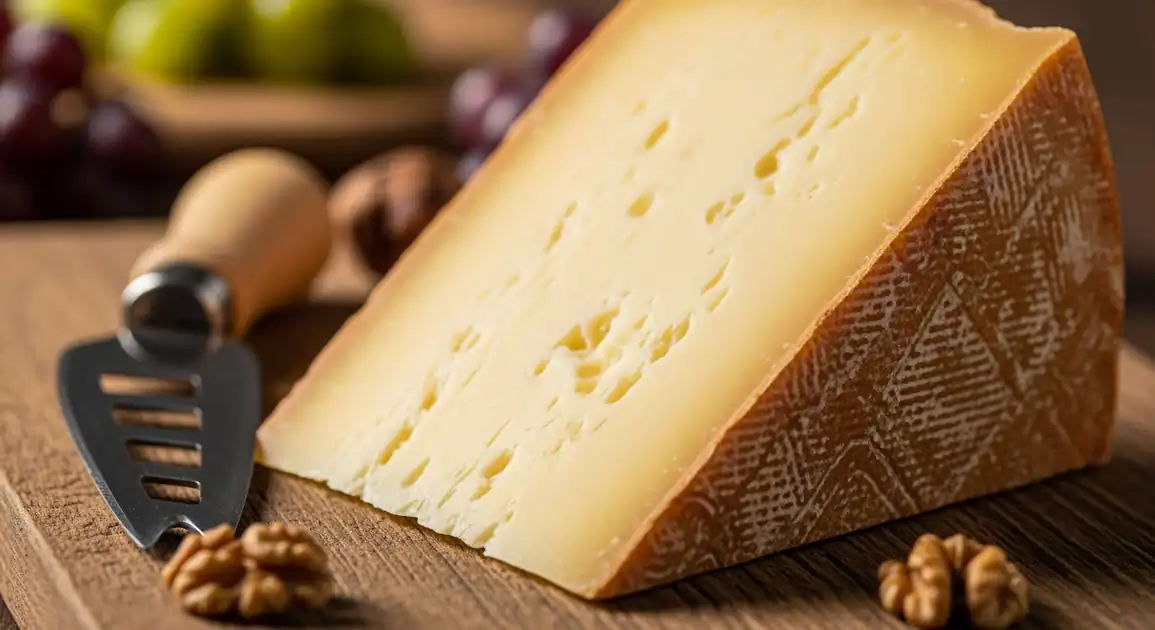Comté Cheese
Comté

Description
Comté is one of France's most popular cheeses, widely available throughout the country in fromageries, markets, and supermarkets. While produced exclusively in the Jura Massif region (Franche-Comté and parts of Rhône-Alpes), its consumption is national. The best selection and expertise are typically found in dedicated cheese shops ('fromageries').
Dietary Information
Serving information
Serving style
Served at room temperature. Sliced or cubed on a cheese board. Essential component of the French cheese course. Pairs well with Jura wines, nuts, fruits, and crusty bread.
Quick facts
Fromageries: Typically Tues-Sat, 10 AM - 1 PM and 3 PM - 7 PM (varies). Markets: Morning hours, specific days.
Safety Tips
What to Look For
-
Reputable Fromagerie/Vendor
Choose specialized cheese shops or trusted market vendors known for quality and proper handling.
-
Cheese Well-Maintained
The cut surface should look fresh, not dried out, cracked, or sweaty. The rind should be clean and intact.
-
Proper Wrapping
Cheese should be wrapped in cheese paper or waxed paper by the vendor. Avoid tightly wrapped plastic for long storage.
-
Knowledgeable Staff ('Fromager'/'Affineur')
Staff should be able to tell you about the cheese's age, flavor profile, and origin.
What to avoid
-
Cheese looks dried out, cracked, or sweaty
Indicates improper storage or that the piece is old/stale.
-
Strong ammonia or sour smell
Indicates spoilage. Comté should smell nutty, fruity, or savory depending on age, but not unpleasant.
-
Visible mold on the cut surface (paste)
While the rind has natural molds, the interior paste should be free of unwanted mold.
-
Pre-cut cheese sitting out uncovered
Increases risk of drying out and potential contamination. Prefer cheese cut fresh or properly wrapped.
Price information
Price range
Budget tips
- Prices are per kilogram. Younger Comté is generally cheaper than older, more aged selections.
- Supermarket prices might be lower but offer less selection and expertise.
- Buying a smaller wedge ('une pointe') is common.
- Look for promotions, especially on younger Comté.
Value indicators
- Clear indication of age ('affinage').
- PDO/AOP label confirms authenticity.
- Reputation of the 'affineur' or shop.
- Ability to taste before buying in fromageries.
Where to Find This Dish
Fromageries (Cheese Shops)
Found in abundance in cities and towns across France. The best place for quality and advice.
Throughout France
Shop hours (often closed Sunday/Monday, check locally)
Local Markets ('Marchés')
Most markets have cheese stalls offering Comté alongside other regional cheeses.
Local market squares
Market days (usually mornings)
Vendor Tips
- Trust the 'fromager' (cheesemonger) – tell them your preferences (age, flavor) and ask for recommendations.
- Always ask to taste ('Je peux goûter?') before buying a cut piece in a fromagerie.
- Look for the AOP label and inquire about the 'affinage' (aging period).
How to Order
Regional Variations
-
Comté Fruité (Fruity)
(Comté Fruité)
Aged approx. 6-12 months. Balanced flavor with distinct nutty and fruity notes. Versatile.
-
Comté Vieux (Old)
(Comté Vieux / Réserve)
Aged approx. 12-18+ months. More intense, complex flavors (roasted, spicy), often with noticeable tyrosine crystals (crunchy bits).
-
Comté Jeune (Young)
(Comté Jeune / Doux)
Aged approx. 4-6 months. Mild, milky, supple texture. Good for melting.
-
Summer Comté
(Comté d'Été)
Made from milk of cows grazing on summer pastures. Often considered more complex and aromatic, with notes of flowers and fruits.
-
Winter Comté
(Comté d'Hiver)
Made from milk of cows fed hay in winter. Flavors might be nuttier, richer, with hints of hay or cooked milk.
Cultural context
History
Comté boasts a long history, with origins dating back over a thousand years to when inhabitants of the Jura mountains needed to preserve milk through the long winters. Farmers pooled their milk in cooperative dairies called 'fruitières' to make large wheels capable of long aging – a tradition that continues today. Comté was one of the first cheeses granted AOC status in 1958, now recognized as AOP (Appellation d'Origine Protégée) across Europe.
Local significance
A cornerstone of French cheese culture and gastronomy. Represents traditional cooperative farming and artisanal cheese maturation ('affinage'). One of the most consumed AOP cheeses in France.
Eating customs
- Served at room temperature.
- The rind is generally not eaten.
- Often enjoyed with bread, not crackers.